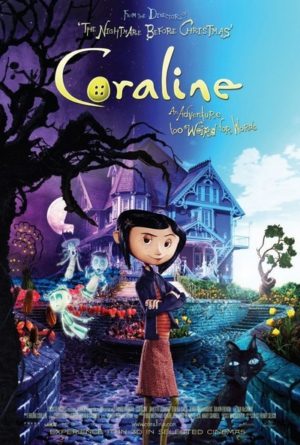 The most extensive stop motion animated feature to date, and a pretty good movie. The writer-director was Henry Selick, adapting the popular novel by Neil Gaiman. It’s a kids’ movie, sure, but an unusually dark and resonant one.
The most extensive stop motion animated feature to date, and a pretty good movie. The writer-director was Henry Selick, adapting the popular novel by Neil Gaiman. It’s a kids’ movie, sure, but an unusually dark and resonant one.
Many people mistakenly identify the 1993 animated classic THE NIGHTMARE BEFORE CHRISTMAS as a Tim Burton film. In point of fact, Burton only partially conceived and co-produced NIGHTMARE; its true visionary was director Henry Selick, whose dark vision and technical mastery are unmistakable. Unfortunately, it took him nearly two decades to produce a worthy follow-up, as JAMES AND THE GIANT PEACH (1996) and the live-action MONKEYBONE (2001) were both duds.
The 2002 novel CORALINE represented a rare (for the time) foray into children’s book writing by the famed graphic novelist Neil Gaiman (of SANDMAN fame). It became a sensation on the kid book circuit, and was snapped up for the screen by Selick. He ended up working several years on the project, resulting in this 2009 claymation production. Exhibited in state of the art 3-D, CORALINE is a benchmark in its field, easily the equal of THE NIGHTMARE BEFORE CHRISTMAS.
Young Coraline has just moved into the Pink Palace, a large country mansion, with her inattentive parents. Both are writers, and neither pays Coraline much attention. Equally annoying is the fact that the Pink Palace is subdivided, with three highly eccentric adults occupying the attic and basement. Also living in the area is a twerp named Wybie who apparently exists solely to irritate Coraline.
One day Coraline discovers a door in the house that opens onto a brick wall. That night she opens it again, and discovers a dark tunnel that leads into another house. This new house looks just like the one Coraline left, but is much prettier. It also harbors parents very much like Coraline’s real mom and dad, but they’re much nicer. The only thing is these new parents have buttons for eyes.
This other world contains much further amazement, including a wondrous garden and a theater whose audience consists of button-eyed dogs. But when Coraline’s other mother proposes sewing buttons onto Coraline’s eyes she decides she’s had enough of this other world. Coraline arrives back in the real world only to discover that her parents have been kidnapped by the other mother, who’s actually a soul-stealing witch.
Coraline will have to find some way to rescue her parents from the evil clutches of the other mother. But the latter is getting angrier, and the alternate world she lives in is growing far scarier.
This being a kid flick, you can expect lots of cloying and cutesy elements. Still, much of the darkness of the Neil Gaiman book has been retained by Henry Selick, whose taste for the macabre and grotesque is fully evident, particularly in the second half. In many respects the film is more flamboyantly gothic than the book, adding elements like a giant spider web that figures unforgettably in the climax.
As an animated spectacle CORALINE simply cannot be improved upon. The big-headed stick-like characters have an utterly distinct look, and move in startlingly lifelike fashion. The lighting, in contrast to most claymation features, is varied and layered, and the camerawork has a verisimilitude that would impress even in a live-action feature.
I can quibble about the 3-D, which was intended primarily to illustrate the film’s two distinct universes. This means that for once the 3-D is utilized in subtle fashion without things being thrust at the camera every few seconds. That’s a good thing, but there isn’t enough of a contrast between Coraline’s two worlds; both were lensed in 3-D, and the visual style in both is too similar.
The vocal performances, however, aren’t at all bad. They’re accomplished by the likes of Dakota Fanning (unforgettable as Coraline), Jennifer Saunders, Dawn French, Keith David and, as Coraline’s mother, Terry Hatcher—yes, that Terry Hatcher!
Vital Statistics
CORALINE
Laika Entertainment/Focus Features
Director: Henry Selick
Producers: Claire Jennings, Mary Sandell
Screenplay: Henry Selick
(Based on a novel by Neil Gaiman)
Cinematography: Pete Kozachik
Editing: Christopher Murrie, Ronald Sanders
Cast: Dakota Fanning, Teri Hatcher, Jennifer Saunders, Dawn French, Keith David, John Hodgman, Robert Bailey Jr., Ian McShane, Aankha Neal, George Selick, Hannah Kaiser, Harry Selick, Emerson Hatcher
